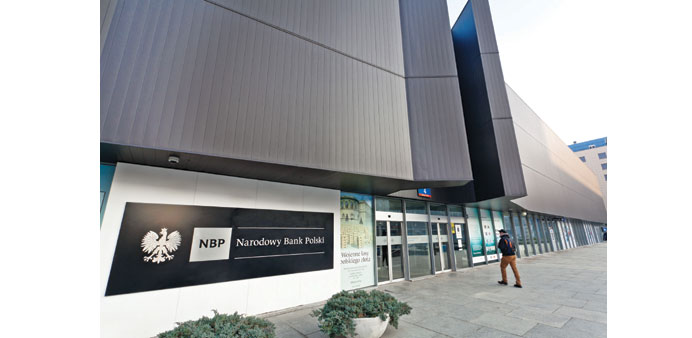A visitor approaches the headquarters of Poland’s central bank, also known as Narodowy Bank Polski (NBP) in Warsaw. After sweeping to power in October elections, lawmakers from the ruling Law & Justice party and their allied president will by the end of February nominate eight new policy makers to the central bank’s 10-member rate-setting board.
Bloomberg
Warsaw
Fresh faces at Poland’s central bank mean the first interest-rate cut since March may come earlier than anticipated.
After sweeping to power in October elections, lawmakers from the ruling Law & Justice party and their allied president will by the end of February nominate eight new policy makers to the central bank’s 10-member rate-setting board, as the terms expire for existing panellists.
The change promises to reshape monetary policy as the new government favours candidates who’ll support rate cuts and a more “active” role for the central bank.
While derivatives used to speculate on borrowing costs show bets for a 25 basis-point rate cut in the second quarter of 2016, the makeup of the Monetary Policy Council is set to tilt toward advocates of lower borrowing costs already in the first three months of next year. Bank Millennium and Credit Agricole say Law & Justice’s appetite to extend its power following eight years in the opposition could mean rates will be cut sooner not later.
“The market consensus seems to be that all its new members have to be appointed before the panel decides to cut,” Mateusz Milewski, a fixed-income trader at Millennium in Warsaw, said on Wednesday. “But judging by how quickly Law & Justice is seizing power, there’s a growing chance they will reduce rates already in February.”
Traders have boosted bets to almost a quarter-point reduction in the next three months, according to forward-rate agreements at 10:14am in Warsaw.
That’s up from 18 basis points on Wednesday and triple the level seen November 17, the day after the new government took power. The six-month forecast is for 38 basis points of cuts.
Further reductions aren’t needed as Poland’s $548bn economy is already on a path of “balanced growth,” central bank Governor Marek Belka said on Wednesday after the Monetary Policy Council kept the benchmark at a record low of 1.5%.
The economy expanded 3.5% in the third quarter from a year earlier and “won’t have any trouble keeping that rate of growth in the coming months,” Belka said. The run of deflation that started in July last year is predicted to end around January, he added.
While terms of only two policy makers end before the central bank’s next meets January 13-14, proponents for rate cuts could reach a majority as early as the following meeting on February 2-3 after the government fills another three seats and two existing rate-setters, appointed by late President Lech Kaczynski — the twin brother of Law & Justice leader Jaroslaw, remain until February 19.
After winning October general elections, Law & Justice has passed legislation that creates a legal quagmire surrounding the country’s top court, rejecting criticism from constitutional lawyers.
The new administration has also forced out the head of the country’s anti-corruption agency, limited the opposition’s oversight of secret services and discussed the appointment of allies to senior posts in the central bank and public media. A majority of Poles believe their country’s democracy is being weakened, according to an opinion poll published this week.
The drumbeat of calls for additional easing has also intensified. Development Minister Mateusz Morawiecki said he saw room for a quarter-point reduction, while Finance Minister Pawel Szalamacha predicted a potential “small” cut in January or February.
“You can’t rule out there’ll be a cut in February, because the new members will have majority,” said Jakub Borowski, the chief economist at Credit Agricole in Warsaw.
“But I expect them to hold off until March.”

